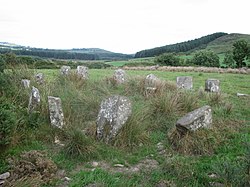| Revision as of 22:36, 20 June 2021 editAnomieBOT (talk | contribs)Bots6,590,853 editsm Dating maintenance tags: {{Fact}}← Previous edit | Latest revision as of 15:51, 23 November 2023 edit undoGuliolopez (talk | contribs)Autopatrolled, Extended confirmed users, Pending changes reviewers, Rollbackers109,603 edits Merged per AfD | ||
| (11 intermediate revisions by 9 users not shown) | |||
| Line 1: | Line 1: | ||
| {{Short description|Megalithic complex in Cork, Ireland}} | |||
| {{Use dmy dates|date=June 2021}} | {{Use dmy dates|date=June 2021}} | ||
| {{Use Irish English|date=June 2021}} | {{Use Irish English|date=June 2021}} | ||
| ] | |||
| __NOTOC__ | |||
| ⚫ | '''Carrigagulla''' is a ] complex 2.9 km north-east of ], ], Ireland.<ref name="WE">{{cite book | last=Weir, A| year=1980 |title=Early Ireland. A Field Guide | publisher=Blackstaff Press | location=Belfast | pages=113–114}}</ref> | ||
| {{Infobox historic site | |||
| ⚫ | It consists of |
||
| | name = Carrigagulla | |||
| The main site is an axial stone circle, 8.2m in diameter, comprising 16 stones, with one misplaced. Their height varies from 30 cm to 90 cm. The long, straight-edged axial stone is not the lowest, and the highest is next to the lower of the two portal stones. A boulder is situated in the center of the circle.<ref name="WE"/> About 250m north, near the River Laney, is another stone circle: of five stones in a D-shape, with an axial stone with a naturally bevelled upper surface.<ref name="WE"/> | |||
| | image = Carrigagulla 0501.jpg | |||
| | embedded = {{Infobox designation list | |||
| | embed =yes | |||
| | designation2 = National Monument of Ireland | |||
| | designation2_offname = Carrigagulla | |||
| | designation2_number = 660<ref>{{cite web |title=National Monuments of County Cork in State Care |url=http://www.archaeology.ie/sites/default/files/media/pdf/monuments-in-state-care-cork.pdf |page=2 |website=heritageireland.ie |publisher=National Monument Service |accessdate=2 July 2020}}</ref> | |||
| }} | |||
| | native_name = Carraig an Ghiolla | |||
| | native_language = ga | |||
| |coordinates = {{coord|52.00043|-8.91635|format=dms|type:landmark_region:IE|display=inline,title}} | |||
| }} | |||
| ⚫ | '''Carrigagulla''' ('']'': Carraig an Ghiolla)<ref>{{Cite web |title=Carraig an Ghiolla/Carrigagulla |url=https://www.logainm.ie/en/11451 |access-date=2022-07-02 |website=logainm.ie |language=en}}</ref> is a ] complex 2.9 km north-east of ], ], Ireland.<ref name="WE">{{cite book | last=Weir, A| year=1980 |title=Early Ireland. A Field Guide | publisher=Blackstaff Press | location=Belfast | pages=113–114}}</ref> | ||
| ⚫ | It consists of an ], two ]s, and an ] stone, which has been moved around a half mile away. | ||
| ==Features== | ==Features== | ||
| Carrigagulla A is |
Carrigagulla A is an {{convert|8|m|ft|adj=mid|-diameter}} stone circle consisting of 16 standing stones circling a central slab.<ref>{{cite web | title=Carigagulla SW | work=The Megalithic Portal | url=http://www.megalithic.co.uk/article.php?sid=744 | access-date=2023-07-27}}</ref> It is thought that there originally may have been 17 stones in place. The Carrigagulla NE stone row consists of five stones, four of which have been moved and are now used as gates. The stone row at Carrigagulla SW is built from three stones, one of which has fallen.<ref>{{cite web | title=Carigagulla SW | work=The Megalithic Portal | url=http://www.megalithic.co.uk/article.php?sid=1808 | access-date=2008-06-12}}</ref> | ||
| Carrigagulla Ogham Stone was discovered by ] during peat cutting, but the exact location of the find is not known. It has been housed in ] since 1940.{{fact|date=June 2021}} | Carrigagulla Ogham Stone was discovered by ] during peat cutting, but the exact location of the find is not known. It has been housed in ] since 1940.{{fact|date=June 2021}} | ||
| ==See also== | |||
| ] | |||
| ==References== | ==References== | ||
| Line 21: | Line 31: | ||
| ==Sources== | ==Sources== | ||
| * {{note|ARCH1}} ''Denis Power (1997). ''Archaeological inventory of County Cork, Volume 3: Mid Cork, 6435 P10.'' ColorBooks. {{ISBN|0-7076-4933-1}}'' | * {{note|ARCH1}} ''Denis Power (1997). ''Archaeological inventory of County Cork, Volume 3: Mid Cork, 6435 P10.'' ColorBooks. {{ISBN|0-7076-4933-1}}'' | ||
| ==External links== | ==External links== | ||
| * | * | ||
| * | * | ||
| * | |||
| {{coord missing|County Cork}} | |||
| {{European Standing Stones}} | {{European Standing Stones}} | ||
| ] | ] | ||
| ] | ] | ||
| ] | ] | ||
| ] | ] | ||
Latest revision as of 15:51, 23 November 2023
Megalithic complex in Cork, Ireland
| Carrigagulla | |
|---|---|
| Native name Carraig an Ghiolla (Irish) | |
 | |
| Coordinates | 52°00′02″N 8°54′59″W / 52.00043°N 8.91635°W / 52.00043; -8.91635 |
| National monument of Ireland | |
| Official name | Carrigagulla |
| Reference no. | 660 |
Carrigagulla (Irish: Carraig an Ghiolla) is a megalithic complex 2.9 km north-east of Ballinagree, County Cork, Ireland.
It consists of an axial stone circle, two stone rows, and an ogham stone, which has been moved around a half mile away.
Features
Carrigagulla A is an 8-metre-diameter (26 ft) stone circle consisting of 16 standing stones circling a central slab. It is thought that there originally may have been 17 stones in place. The Carrigagulla NE stone row consists of five stones, four of which have been moved and are now used as gates. The stone row at Carrigagulla SW is built from three stones, one of which has fallen.
Carrigagulla Ogham Stone was discovered by Coillte Teoranta during peat cutting, but the exact location of the find is not known. It has been housed in Cork Public Museum since 1940.
References
- "National Monuments of County Cork in State Care" (PDF). heritageireland.ie. National Monument Service. p. 2. Retrieved 2 July 2020.
- "Carraig an Ghiolla/Carrigagulla". logainm.ie. Retrieved 2 July 2022.
- Weir, A (1980). Early Ireland. A Field Guide. Belfast: Blackstaff Press. pp. 113–114.
- "Carigagulla SW". The Megalithic Portal. Retrieved 27 July 2023.
- "Carigagulla SW". The Megalithic Portal. Retrieved 12 June 2008.
Sources
- Denis Power (1997). Archaeological inventory of County Cork, Volume 3: Mid Cork, 6435 P10. ColorBooks. ISBN 0-7076-4933-1